|
|
|
ANIMALS IN AFRICA
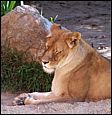 The
lion is a carnivorous animal that is presented as an icon of power, bravery
and royalty. Lions are mostly found in savannas, grasslands, dense bushes and
woodlands. Lions can go for four or five days without water. They seem to get
required moisture from the stomach contents of their prey. They sleep up to
20 hours each day. The females do the hunting whilst the males relax. Lions
could disappear from West and Central Africa within the next ten years because
their populations are fragmented and too small to survive.
The
lion is a carnivorous animal that is presented as an icon of power, bravery
and royalty. Lions are mostly found in savannas, grasslands, dense bushes and
woodlands. Lions can go for four or five days without water. They seem to get
required moisture from the stomach contents of their prey. They sleep up to
20 hours each day. The females do the hunting whilst the males relax. Lions
could disappear from West and Central Africa within the next ten years because
their populations are fragmented and too small to survive.
 Tigers
are man-eaters.They are the biggest cats in thhe world. They live in jungles
as well as cold forests. They mostly have an orange coat with black stripes
accented with white.Tigers are striped and this act as camouflage and help them
hide from their prey. A tiger's paw prints are called pug marks. A tiger's tail
is 3 to 4 feet long, about half as long as its body. Tigers use their tails
for balance when they run through fast turns. They also use their tails to communicate
with other tigers.
Tigers
are man-eaters.They are the biggest cats in thhe world. They live in jungles
as well as cold forests. They mostly have an orange coat with black stripes
accented with white.Tigers are striped and this act as camouflage and help them
hide from their prey. A tiger's paw prints are called pug marks. A tiger's tail
is 3 to 4 feet long, about half as long as its body. Tigers use their tails
for balance when they run through fast turns. They also use their tails to communicate
with other tigers.
 Zebras
(herbivores) are equid, long lived animals that move fast for their huge size
and have teeth built for chewing and cropping grass.They have horse like bodies,
but their manes are made of short, erect hair, their tails are tufted at the
tip .They like tigers are striped and it is believed that the strips help them
withstand intense solar radiation. The black and white stripes are a form of
camouflage called disruptive coloration that breaks up the outline of the body.
Although the pattern is visible during daytime, at dawn or in the evening when
their predators are most active, zebras look indistinct and may confuse predators
by distorting true distance. Although they are adapted to semi-arid conditions
and require less water than other zebra species, these zebras compete with domestic
livestock for water and have suffered heavy poaching for their meat and skins.
They live in woodlands to open plains.
Zebras
(herbivores) are equid, long lived animals that move fast for their huge size
and have teeth built for chewing and cropping grass.They have horse like bodies,
but their manes are made of short, erect hair, their tails are tufted at the
tip .They like tigers are striped and it is believed that the strips help them
withstand intense solar radiation. The black and white stripes are a form of
camouflage called disruptive coloration that breaks up the outline of the body.
Although the pattern is visible during daytime, at dawn or in the evening when
their predators are most active, zebras look indistinct and may confuse predators
by distorting true distance. Although they are adapted to semi-arid conditions
and require less water than other zebra species, these zebras compete with domestic
livestock for water and have suffered heavy poaching for their meat and skins.
They live in woodlands to open plains.
 Porcupines
are relatively abundant, but as they are nocturnal, they are infrequently seen
in the daytime. Of the three species found in East Africa, the crested porcupine
is the most widespread, followed by the South African porcupine. The smaller,
more slender African brush-tailed porcupine is found in isolated populations
in northwestern Kenya. Porcupines are most common in hilly, rocky country, but
they can adapt to most habitats. Excessively moist forests and the most barren
of deserts seem to be the only exceptions. The porcupine is capable of putting
on a very aggressive display, but it is basically timid. It is occasionally
the target of predators such as pythons and leopards, sometimes to the detriment
of the predator, which can die from quill wounds. Predators have been found
dead with a porcupine lodged in their throat. Large owls also prey on young
porcupines. Porcupine quills have long been a favorite ornament and good-luck
charm in Africa. The hollow rattle quills serve as musical instruments and were
once used as containers for gold dust.
Porcupines
are relatively abundant, but as they are nocturnal, they are infrequently seen
in the daytime. Of the three species found in East Africa, the crested porcupine
is the most widespread, followed by the South African porcupine. The smaller,
more slender African brush-tailed porcupine is found in isolated populations
in northwestern Kenya. Porcupines are most common in hilly, rocky country, but
they can adapt to most habitats. Excessively moist forests and the most barren
of deserts seem to be the only exceptions. The porcupine is capable of putting
on a very aggressive display, but it is basically timid. It is occasionally
the target of predators such as pythons and leopards, sometimes to the detriment
of the predator, which can die from quill wounds. Predators have been found
dead with a porcupine lodged in their throat. Large owls also prey on young
porcupines. Porcupine quills have long been a favorite ornament and good-luck
charm in Africa. The hollow rattle quills serve as musical instruments and were
once used as containers for gold dust.
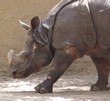 Rhinoceros's
are mostly found Grasslands and open savannas. Rhinos declined drastically in
the 1970s and 1980s due to poaching. To prevent extinction, many rhinos were
translocated to fenced sanctuaries in the early 1990s. This effort appears to
be succeeding, as 1994 was the first time in 20 years that rhino numbers did
not decline. The rhino is prized for its horn. Not a true horn, it is made of
thickly matted hair that grows from the skull without skeletal support. The
major demand for horn is in Asia, where it is used in traditional medicine and
ornamental carvings. Man is the cause of the demise of the rhino. In the wild,
the adult black or white rhino has no true natural predators and, despite its
size and antagonistic reputation, it is extremely easy for man to kill. A creature
of habitat that lives in a well-defined home range, it usually goes to water
holes daily, where it is easily ambushed. The dramatic decline in rhino numbers
is unfortunate in an era of increasing conservation and wildlife awareness,
but efforts are underway to save the rhino from extinction.
Rhinoceros's
are mostly found Grasslands and open savannas. Rhinos declined drastically in
the 1970s and 1980s due to poaching. To prevent extinction, many rhinos were
translocated to fenced sanctuaries in the early 1990s. This effort appears to
be succeeding, as 1994 was the first time in 20 years that rhino numbers did
not decline. The rhino is prized for its horn. Not a true horn, it is made of
thickly matted hair that grows from the skull without skeletal support. The
major demand for horn is in Asia, where it is used in traditional medicine and
ornamental carvings. Man is the cause of the demise of the rhino. In the wild,
the adult black or white rhino has no true natural predators and, despite its
size and antagonistic reputation, it is extremely easy for man to kill. A creature
of habitat that lives in a well-defined home range, it usually goes to water
holes daily, where it is easily ambushed. The dramatic decline in rhino numbers
is unfortunate in an era of increasing conservation and wildlife awareness,
but efforts are underway to save the rhino from extinction.
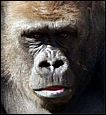 Gorilla,
largest of the great apes and one of the closest living relatives of the human
species. Gorillas are members of the primate order.The gorilla is massive, with
a short, thick trunk and broad chest and shoulders. Its eyes and ears are dwarfed
by its large head and hairless, shiny black muzzle. Older males develop a crown
of muscle and hair that makes the head look even longer. The arms are longer
than the stubby legs. The fully adult male mountain gorilla is twice as large
as the female. · Gorillas rarely attack humans. But in an encounter a person
should stay still and refrain from staring or pointing at the gorilla. · Gorillas
are susceptible to various parasites and diseases, especially to pneumonia during
the long, cold wet seasons.
Gorilla,
largest of the great apes and one of the closest living relatives of the human
species. Gorillas are members of the primate order.The gorilla is massive, with
a short, thick trunk and broad chest and shoulders. Its eyes and ears are dwarfed
by its large head and hairless, shiny black muzzle. Older males develop a crown
of muscle and hair that makes the head look even longer. The arms are longer
than the stubby legs. The fully adult male mountain gorilla is twice as large
as the female. · Gorillas rarely attack humans. But in an encounter a person
should stay still and refrain from staring or pointing at the gorilla. · Gorillas
are susceptible to various parasites and diseases, especially to pneumonia during
the long, cold wet seasons.
 Giraffes
are found in arid and dry-savanna zones south of the Sahara, wherever trees
occur. They are the tallest mammals in the world. They grow up to 18ft tall.
They are unique in that they have a beautiful skin with brown patches. Giraffes
are herbivores, and their long necks allow them to reach the tasty leaves and
shoots of thorny acacia trees. Despite their long necks, giraffes have only
seven vertebrae, exactly the same number as man and most other mammals. Even
though giraffes are often seen together in groups, they do not form the complex
social groups of many plains species. Theirs are loose associations, constantly
changing in make-up. In fact, giraffe tail hairs are still collected for jewelry,
and hide is used to make sandals and ceremonial shields. Some tribes treat nosebleeds
with the smoke from burning giraffe skin. Unfortunately giraffes antagonize
farmers more and more, often when the animals forage on crops and compete with
domestic stock for resources. This conflict is likely to escalate in the future
as the African human population continues to increase. Giraffes live for 20
to 25 years, and their spots get darker with the age.
Giraffes
are found in arid and dry-savanna zones south of the Sahara, wherever trees
occur. They are the tallest mammals in the world. They grow up to 18ft tall.
They are unique in that they have a beautiful skin with brown patches. Giraffes
are herbivores, and their long necks allow them to reach the tasty leaves and
shoots of thorny acacia trees. Despite their long necks, giraffes have only
seven vertebrae, exactly the same number as man and most other mammals. Even
though giraffes are often seen together in groups, they do not form the complex
social groups of many plains species. Theirs are loose associations, constantly
changing in make-up. In fact, giraffe tail hairs are still collected for jewelry,
and hide is used to make sandals and ceremonial shields. Some tribes treat nosebleeds
with the smoke from burning giraffe skin. Unfortunately giraffes antagonize
farmers more and more, often when the animals forage on crops and compete with
domestic stock for resources. This conflict is likely to escalate in the future
as the African human population continues to increase. Giraffes live for 20
to 25 years, and their spots get darker with the age.
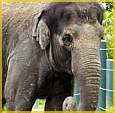 The
African elephant is the largest living land mammal, one of the most impressive
animals on earth. Elephants can live in nearly any habitat that has adequate
quantities of food and water. Their ideal habitat consists of plentiful grass
and browse. Its high level of intelligence, interesting behavior, methods of
communication and complex social structure distinguish it. Elephants seem to
be fascinated with the tusks and bones of dead elephants, fondling and examining
them. The myth that they carry them to secret "elephant burial grounds," however,
has no factual base. Elephants are very social, frequently touching and caressing
one another and entwining their trunks. Elephants demonstrate concern for members
of their families they take care of weak or injured members and appear to grieve
over a dead companion.
The
African elephant is the largest living land mammal, one of the most impressive
animals on earth. Elephants can live in nearly any habitat that has adequate
quantities of food and water. Their ideal habitat consists of plentiful grass
and browse. Its high level of intelligence, interesting behavior, methods of
communication and complex social structure distinguish it. Elephants seem to
be fascinated with the tusks and bones of dead elephants, fondling and examining
them. The myth that they carry them to secret "elephant burial grounds," however,
has no factual base. Elephants are very social, frequently touching and caressing
one another and entwining their trunks. Elephants demonstrate concern for members
of their families they take care of weak or injured members and appear to grieve
over a dead companion.
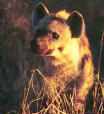 The
hyena is Africa's most common large carnivore. Over the years hyenas and humans
have come into close contact in Africa and, in earlier times, in Asia and in
Europe, often leading to mutual predation. In ancient Egypt hyenas were domesticated,
fattened and eaten, and in turn humans have on occasion become food for hyenas.
Reputed to be cowardly and timid, the hyena can be bold and dangerous, attacking
animals and humans. Spotted hyenas are found in grasslands, woodlands, savannas,
sub deserts, forest edges and mountains.. Hyenas make a variety of vocalizations,
including wailing calls, howling screams and the well-known "laughter" used
to alert other clan members up to three miles away of a food source. Hyenas
eat a great variety of animal products, vegetation and, according to campers,
even aluminum pots and pans.
The
hyena is Africa's most common large carnivore. Over the years hyenas and humans
have come into close contact in Africa and, in earlier times, in Asia and in
Europe, often leading to mutual predation. In ancient Egypt hyenas were domesticated,
fattened and eaten, and in turn humans have on occasion become food for hyenas.
Reputed to be cowardly and timid, the hyena can be bold and dangerous, attacking
animals and humans. Spotted hyenas are found in grasslands, woodlands, savannas,
sub deserts, forest edges and mountains.. Hyenas make a variety of vocalizations,
including wailing calls, howling screams and the well-known "laughter" used
to alert other clan members up to three miles away of a food source. Hyenas
eat a great variety of animal products, vegetation and, according to campers,
even aluminum pots and pans.
 Savanna
buffaloes are large, heavy cow like animals. They vary greatly not only in size,
but in the shapes of their horns and color. Adults are usually dark gray or
black (or even look red or white if they have been wallowing in mud of that
color) and the young are often reddish-brown. The smaller forest buffalo maintains
the red color even as an adult, although in western Uganda, many savanna buffaloes
are also red or pale orange instead of black. Adults lose hair as they age.
Both savanna buffaloes and forest buffaloes live close to water. In general
buffaloes are found throughout the northern and southern savanna as well as
the lowland rain forest. The African buffalo differs from the domesticated water
buffalo found in other parts of the world, although they both superficially
resemble one another. The buffalo is one of the most abundant of Africa's large
herbivores. It depends on water and does not live in regions with less than
10 inches of rain a year.
Savanna
buffaloes are large, heavy cow like animals. They vary greatly not only in size,
but in the shapes of their horns and color. Adults are usually dark gray or
black (or even look red or white if they have been wallowing in mud of that
color) and the young are often reddish-brown. The smaller forest buffalo maintains
the red color even as an adult, although in western Uganda, many savanna buffaloes
are also red or pale orange instead of black. Adults lose hair as they age.
Both savanna buffaloes and forest buffaloes live close to water. In general
buffaloes are found throughout the northern and southern savanna as well as
the lowland rain forest. The African buffalo differs from the domesticated water
buffalo found in other parts of the world, although they both superficially
resemble one another. The buffalo is one of the most abundant of Africa's large
herbivores. It depends on water and does not live in regions with less than
10 inches of rain a year.
Thanks to African Wildlife Foundation
ADA LETTE